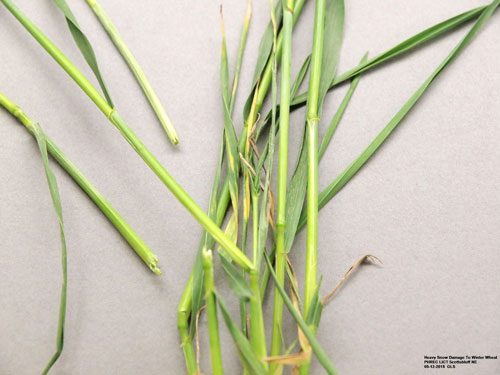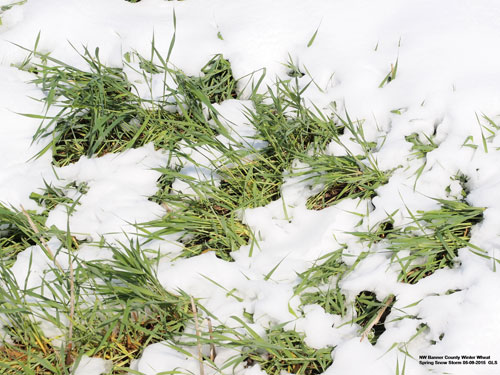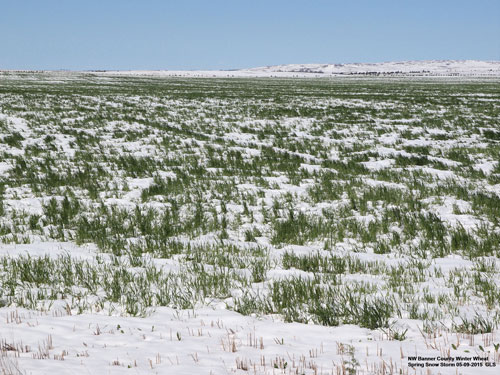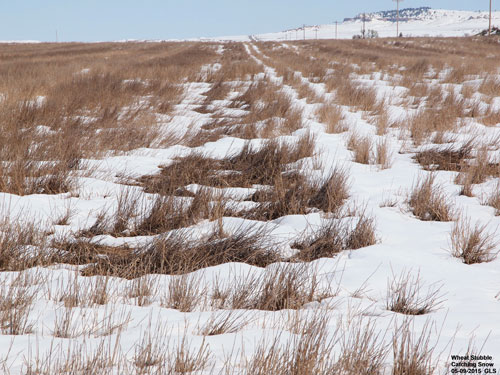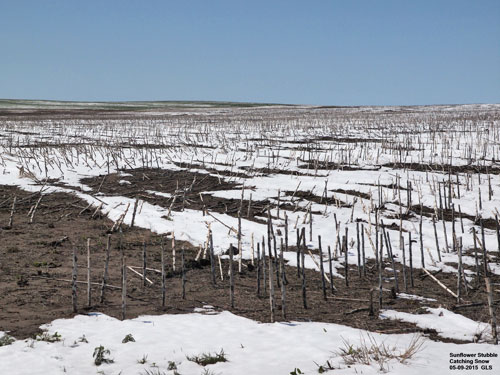Freeze-Damaged Winter Wheat in the Panhandle
Most of the winter wheat growing regions from the southern Panhandle into South Dakota received 6 to 18 inches of snow May 9-10. Earlier photos by Gary Stone (Figures 3-6) showed wheat weighed down by snow. Research plots at Scottsbluff look similar and snow was mostly melted by late Monday.
From the road on Tuesday afternoon the wheat appeared to have recovered (Figure 1). On closer inspection, when plots were sampled, many of the stems were broken or crimped (Figure 2). Damage ranged from 10% to 40% stem breakage/crimping. Therefore, careful field inspection and sampling are necessary to estimate the degree of, damage. The broken and crimped stems will affect both grain yield and quality.
Although wheat can compensate since remaining tillers with viable heads (if not damaged by cold temperatures) will produce somewhat more grain, wheat will not compensate for lost stems if loss is above 25%-30%. Growers are encouraged to scout fields to assess damage. Having some idea about damage now and in a week or 10 days when damaged stems are brown and more noticeable will give producers an idea of yield and grain quality loss and reduce the surprise at harvest. If growers already had sub-par stands caused by winter kill, they definitely need to evaluate yield potential to see if taking the wheat to harvest is their best choice.
Our concern is the amount of acreage that could have potential damage. In the Panhandle Crop Reporting District over 695,000 acres were planted to wheat in 2013 (Table 1). (Final planted acre data for the 2015 winter wheat crop are not yet available.) Since all of this area had heavy, wet snow, the impact could be significant.
| Table 1. Nebraska planted approximately 1.55 million acres of winter wheat in fall 2013, about 45% of that in Panhandle counties (below). (Source USDA NASS) | ||
| County | Fall 2013 Planted Acres |
Percent of Panhandle Acreage |
| Banner | 50,900 | 7.3% |
| Box Butte | 108,100 | 15.5% |
| Cheyenne | 187,700 | 27.0% |
| Dawes | 32,100 | 4.6% |
| Deuel | 80,00 | 11.5% |
| Garden | 44,200 | 6.4% |
| Kimball | 100,600 | 14.5% |
| Morrill | 27,300 | 3.9% |
| Scotts Bluff | 9,700 | 1.4% |
| Sheridan | 49,100 | 7.1% |
| Sioux | 5,700 | 0.8% |
| Total | 695,400 | |
Options after Determining Damage
Wheat producers with significant damage have several choices. The first and least expensive is to leave the growing crop and take it to harvest. Depending on your crop insurance coverage, this may not make money but it may keep you from losing money. The grain yield will probably be low with poor quality. The projected price on crop insurance for wheat is $6.41 per bushel, so producers with revenue coverage may have an attractive revenue guarantee, relative to expected actual revenue from both lower yields and lower prices.
A second option is to take the crop for forage — either as harvested hay or for grazing. Growers would need to review their herbicide program for harvest or grazing restrictions and check crop insurance provisions for fallow eligibility. If grazing, bloat prevention blocks or similar supplements containing magnesium and calcium should be placed in the field for the livestock.
A third option is to terminate the wheat then plant back to proso millet, corn, or sunflower. Current corn price versus production costs may be a deterrent. Sorghum is an option, however, yield results in past research plots at Sidney have shown variable yields because of maturity and iron chlorosis problems. For more information see the UNL Crop Production Budgets. Tillage is not recommended to terminate the crop due to soil moisture loss. Roundup is probably the best option. Because spring precipitation has been above normal over most of the Panhandle, stored soil moisture in growing wheat is excellent. Growers need to review their herbicide program to make sure there would be no plant-back restrictions and they should check crop insurance provisions for fallow eligibility.
Related Articles
- Assessing Freeze Damage to Wheat in this week's CropWatch
- Freeze Injury to Nebraska Wheat (Nebraska Extension EC132)
- Differentiating Symptoms of Soilborne Diseases from Winter Injury in Wheat
Gary Hergert, Extension Soils Specialist, Gary Stone, Extension Educator, Dipak Santra, Alternative Crops Breeding Specialist, and Cody Creech, Dryland Crops Specialist, and Jessica Johnson, Extension Educator, all at the Panhandle REC
Online Master of Science in Agronomy
With a focus on industry applications and research, the online program is designed with maximum flexibility for today's working professionals.


